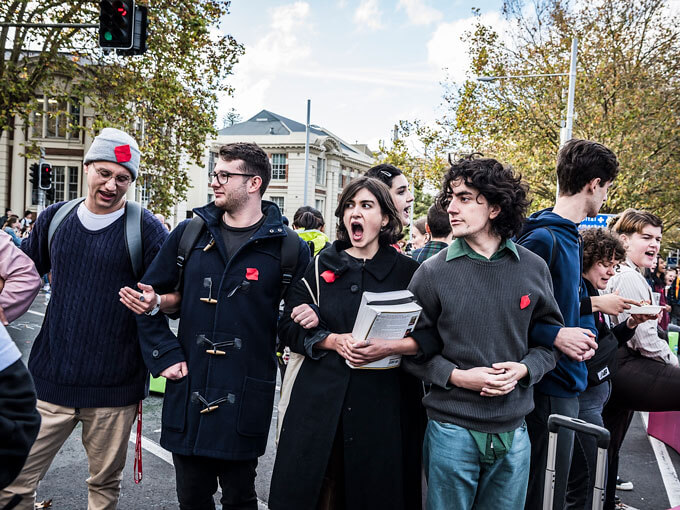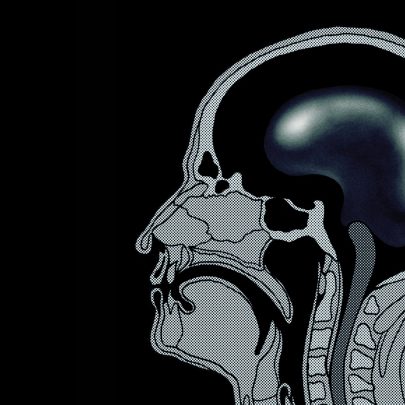Apr 3, 2019 Schools
In 2018, the decision to close three specialist libraries at the University of Auckland sparked an outcry, not just about the fate of the libraries, but what it said about the institution’s culture. Metro examines how the university ended up here and asks what’s next for a tertiary sector at the crossroads.
For many of his toughest critics, the University of Auckland’s longstanding vice-chancellor, Stuart McCutcheon, is the archetypal manifestation of the free-market-era campus boss. At the library-closure protests in May, banners and placards reading “VC McCutcheon, Whose Side Are You On?” and “Stuart’s Got 2 Go” summed up a growing mood of discontent about his leadership and a sense of betrayal, particularly among arts students and faculty. (In fact, he is going: aged 65, he’s retiring at the end of 2019.)
There’s his apparent fixation with STEM — science, technology, engineering and mathematics — and flash buildings to do it in. The $700,000 salary. The sharp suits. The Northern Club membership. The CEO swagger.
On his watch, some of his critics say, top-down managerialism has become standard practice at the university, and a kind of bureaucratic cynicism permeates an army of middle managers. More than one source spoken to for this story said McCutcheon himself doesn’t take criticisms of management decisions well, and that all of this has had a chilling effect on the willingness of staff to speak out against administrative decisions.
In 2018, this tension came to a nasty head. It started with the proposal that three creative arts libraries — music and dance, fine arts, architecture and urban planning — should be closed, their collections absorbed into the university’s general library in Alfred St, and jobs lost as a result. The Tertiary Education Union (TEU) representative Enzo Giordani issued an ominous warning: more slashing and burning was just around the corner.
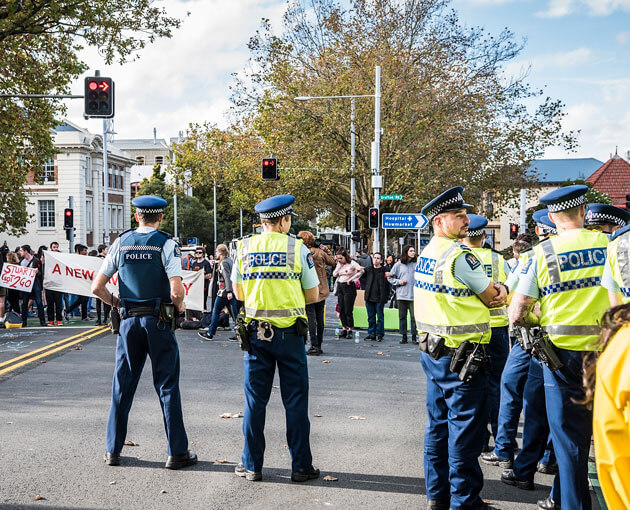
Cuts came in the faculty of music and the faculty of education and social work, which is also going to be moved from its Epsom campus, where generations of teachers have trained.
When it came to the library closures, many staff and students, particularly at the Elam School of Fine Arts, decided enough was enough. There were public meetings, “teach-ins” and rallies. Students shut down Symonds St traffic for four hours. There were heated exchanges of letters between the TEU and McCutcheon, and accusations that the university leadership was stifling academic freedoms and gagging staff from speaking out.
Heavy-hitting English professors past and present, including Brian Boyd, Wystan Curnow, CK Stead, Michael Neill, Witi Ihimaera and Albert Wendt chimed in, writing a searing op-ed for the Herald in which they argued that the libraries decision “is a symptom of a much deeper sickness afflicting universities in this neo-liberal age that began in the mid-1980s, when vice-chancellors were formally redefined as CEOs”.
Read more: The closure of a specialist architecture library reminds us of its great impact
Read more: Heated rally against shut uni libraries: ‘It means the death of fine arts’
For one side, these upheavals represent the tip of an ideological iceberg: a sense that, for years now, the arts have been under attack in an institution, backed by successive governments, that values STEM subjects above all else; that McCutcheon wields too much power; and that, consequently, the university has lost its way — lost its democracy, and its commitment to critical thinking, creativity and free expression.
For the other side, though, this is simply the reality of 21st-century university life. In a globally competitive environment and operating with straitened budgets, tough decisions get made, and leaders like McCutcheon — cast more from the mould of corporate CEO than pointy-headed academic — are the people who make those difficult calls for the greater fiscal good. Three separate libraries, serving four per cent of the university’s population, were, in this framework, ripe for a restructure. Likewise, departments with waning student enrolments.
The brutal truth is, both sides are absolutely right. The events of 2018 have exposed the cracks at New Zealand’s largest university. But those cracks run far deeper, and wider, than one man’s tenure as vice-chancellor.
This is a story about a tertiary sector at the crossroads. And the path chosen from here is going to have a huge impact on the shape of our universities — and their place in our collective public life — in the coming decades.
If the University of Auckland were a business, McCutcheon tells me in his office in the university’s clock tower building, it would be about the 35th largest in the country. More than a billion dollars in turnover, even more than that in assets. Its 2017 annual report was ebullient in assessing its own significance: more than 5000 full-time-equivalent staff; the top-ranked university in the country; 16 of its subjects ranked in the top 50 in the world; first in New Zealand for 37 out of 40 subjects it’s ranked in; world-class researchers across the organisation. Based on the numbers, it is the jewel in New Zealand’s tertiary education crown.
But TEU national president Sandra Grey says the mood among many faculty is grim. “People are so fearful now, they won’t even speak out in their own collegial meetings, let alone speak up publicly,” she says. “There’s no way that you can have a really strong University of Auckland when no one is allowed to talk about what’s going on. You don’t get good policy decisions, you don’t get good institutional decisions.”
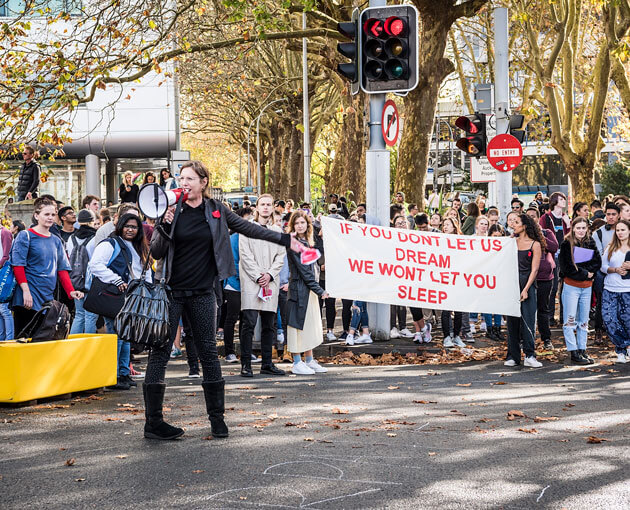
In the middle of 2018, Grey and McCutcheon exchanged letters, which the TEU published on its website. In the wake of the libraries decision and music lay-offs, Grey accused the university leadership of using consultation processes to gag staff. As evidence, she cited the fact that change-management documents included wording to the effect that employees owed their loyalty and fidelity to the vice-chancellor as their employer, and should therefore not speak to media while employment reviews were being undertaken (several faculty and graduates spoken to for this story would only do so off the record). This, she argued, was in direct contradiction with the legislatively protected responsibility of universities to be the “critic and conscience” of society.
McCutcheon’s written reply to Grey’s letter boiled down to this: tosh. Grey, he wrote back, was drawing a long bow from the legal requirement of confidentiality around specific employment matters to wider questions of academic freedom. In the cases of restructuring, he said, employment law rules supreme. Negotiations need to be undertaken in good faith, by both sides. And he, as the university’s employer-in-chief, has a duty to follow the letter of the law.
When I ask McCutcheon about the letters, he is adamant that the reference to “obligations of loyalty and fidelity” referred only to the staff whose jobs were being restructured. “First of all, it’s true,” he says. “Employees have a duty of fidelity to their employer, and their employer has a duty of fidelity to them. So that’s perfectly clear.”
He also rejects the accusation that his approach to consultation is stifling academic freedom, and laughs off the suggestion that his own skin is sufficiently thin that he would silence people critical of him.
“People don’t have a duty of fidelity that prevents them criticising me, not in the slightest,” he says. “If a staff member wants to pop up in the newspaper and say the vice-chancellor shouldn’t have done this or the vice-chancellor shouldn’t have done that or the vice-chancellor’s taken leave of his senses, I’m perfectly relaxed about that. It happens all the time. I’ve been doing this for 20 years. It’s an occupational hazard.”
That McCutcheon himself has become such a focal point is partly down to the foibles of the modern role of vice-chancellors in New Zealand universities. Historically, they have always been the academic leaders of their institutions. This is still in place: for example, McCutcheon is the chair of his university’s senate, a House of Lords-type body responsible for academic matters. But the VC is also a university’s employer. And in the case of the library closures, McCutcheon took the view that the restructure was, primarily, an employment issue. Which is not to say it wasn’t an academic issue, too — but rather that employment questions trumped academic ones.
“You can argue that everything is an academic issue,” he says, “and at some point you have to draw a line and say, well, this is an academic issue, and this isn’t. So in that particular case [of the libraries], we went out and consulted with the affected staff, which is what the university policy says we’re obliged to do. Now, if one wanted to argue to change the policy, that’s fine. But you have to argue to change a university policy ahead of using it, not in the middle of using it.”
Grey, though, says this is symptomatic of the university’s approach to consultation, in which terms are defined so narrowly that wider communities affected by restructuring decisions are cut out. “That belies the whole idea that these are public institutions that are publicly accountable, that they are to deliver for the public good,” she says. “And I think it’s making for a very unhealthy culture.”
On April 30, 2018, 81 faculty from the departments affected by the library closures put their names to a document criticising the consultation process and calling for it to be re-evaluated. Why, I ask McCutcheon, weren’t their voices heard?
“They were heard, of course,” he says. “But actually people didn’t really object to the procedure. What they objected to was the outcome. They objected to what was proposed, and being unhappy about the procedure is kind of a second-order thing. What they didn’t want is their libraries closed, and I understand that, and I have some sympathy with them. But equally, we have to deal with the finances of the university, and we knew from benchmarking against a whole bunch of Australasian universities that we had the most expensive library system in Australasia, and it was expensive primarily because it was so dispersed.”
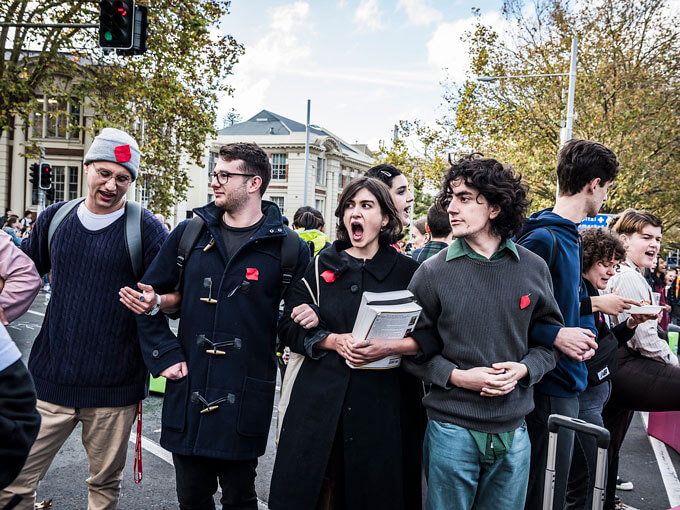
This, and the events of June 21 — when the dean of creative arts and industries, Diane Brand, and the director of libraries and learning services, Sue Roberts, met student representatives to tell them the decision to centralise the libraries’ collections had been made — don’t do much to allay the sense many students and staff felt, and still feel, that it was a done deal: a consultation in name only.
But it can just as easily be argued that McCutcheon was simply doing his job. Though notionally both, the current generation of vice-chancellors are more like private-sector CEOs than academic leaders, and as such, have to decide how to spend their budgets most effectively. And in the case of the libraries, management decided that keeping them open was simply too expensive.
It’s also true, though, that several of New Zealand’s vice-chancellors have, over the years, inhaled ever deeper from the free-market pipe. In the modern era, our universities have been framed by successive governments, and university management, as competitive businesses in a global marketplace, where a strong brand is the difference between success and failure. Locally, too, there’s a sense our major institutions are vying against each other for international rankings, research scores, and, most important of all, student bums on lecture-hall seats.
McCutcheon believes competition has been a good thing for the sector. The problem, he argues, is not that there are other providers in the market. It’s the way central Government funds the marketplace.
There are two parts to this. The first is that the amount universities are allowed to charge students is set by the Government (so it’s not, in this sense, a pure market model), and the amount the Government then chips in per student is the same for all institutions. In other words, higher-ranked universities don’t get any significant financial boost for performing better.
But the second is something even McCutcheon and Grey agree on: that New Zealand’s tertiary sector has been woefully starved of resources for two decades. For over 20 years, McCutcheon says, governments have been motivated to screw down funding. Many academics agree: as one told me, all the fat has already been stripped from the system, and now it’s having to consume vital services — like, for example, specialist libraries.
One of McCutcheon’s common refrains is that New Zealand has among the lowest per-capita spends on tertiary education in the developed world. And this, he argues, has had a direct effect on his university’s international rankings — from being comfortably inside the top 100 in the Times Higher Education list, to now being somewhere between 200th and 250th.
He even puts a figure on the financial shortfall. If the university had received funding increases at appropriate levels over the past 10 years, he tells me — which, based on international parallels, he puts at 1.6 times the consumers price index — it would be able to afford an additional 600 staff. That’s a staggering number, when the total workforce is currently 5000 full-time-equivalent roles.
How, then, did we end up in this situation, with massive underfunding and understaffing, a STEM bias, library closures, unhappy arts faculty worrying that the next restructure is just around the corner, staff fretting about talking to the media lest it hurt their professional prospects, and New Zealand universities tumbling down the global rankings? As one senior academic put it to me, this is some very big, systemic chickens coming home to roost.
In 2000, under the leadership of then vice-chancellor John Hood, the University of Auckland became the key institutional partner for Helen Clark’s Government in its “Catching the Knowledge Wave” project. The project’s ambitions were central to the promises of the Labour/Alliance centre-left agenda: a kind of “shoot for the stars” economic rally cry for New Zealanders, with tertiary education — and an embrace of innovation, technology and “knowledge-based creativity” — at its heart.
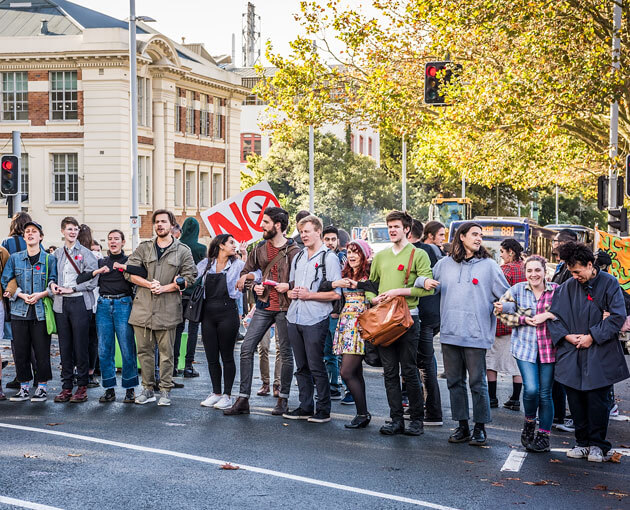
At the time, the internet was new and shiny, and so, in New Zealand, was the mainstreaming of Third Way politics: the belief that nations could embrace entrepreneurship and free trade without losing their safety nets and social cohesion. Everyone, the logic went, could be a winner in the 21st-century economy. But to take part in that utopia, young people needed a tertiary qualification — and, to get to the top of the knowledge-economy food-chain, that qualification should ideally be a university degree.
Clark’s Government bit down hard on the Third Way leather and dramatically reshaped the tertiary sector. This started with the establishment of the Tertiary Education Advisory Commission. Its recommendations, many of which were absorbed as significant amendments to the 1989 Education Act in 2002, still define the sector today.
One of the biggest changes was the creation of the Tertiary Education Commission (TEC) as a kind of buffer agency between tertiary education organisations (TEOs) like universities, and the Government. The TEC framework is dripping in business-speak: to receive funding, TEOs must submit “investment plans”, which essentially become “contracts”, and the decisions about how to allocate funds are made by “investment managers”. The TEC’s funding decisions are also guided by the government of the day’s tertiary education strategy, which is rewritten every five years — a mechanism designed to better align the tertiary sector with the national economic interest.
By far the biggest chunk of funding TEC allocates is the student achievement component, based on the number of domestic equivalent full-time students (EFTS) a TEO enrols. This, combined with the fees the students themselves pay, is the bulk of a TEO’s funding. That leaves them with only a handful of ways to raise additional cash.
One of the most important is something most academics groaningly recognise as a four-letter obscenity: the PBRF. The performance-based research fund is a system for assessing and ranking every “active researcher” within the tertiary sector. Every six or so years, a nationwide faculty census is carried out, and the TEOs then submit portfolios for individual researchers. The portfolios are assessed by a panel of fellow academics who grade the quality of the research, using an A-B-C system (that assessment process is going on right now). The different grades attract different levels of cash, which is paid out to the researchers’ institution. What matters most is internationally recognised, peer-reviewed work. If TEOs attract external research income from, say, the private sector, they also get an additional top-up from the Government.
The other major way TEOs raise income is from international students. Unlike domestic students, internationals pay the full cost of their education, and are therefore bonus money. This helps to explain a couple of things. First, why international rankings really, really matter to our universities — because the pursuit of international students is a genuinely cut-throat global market. And second, the colossal mess that was the Indian-student debacle. The structure of the funding system implicitly incentivises TEOs — particularly private training establishments run for profit — to go after internationals. Little wonder, then, that some bad actors in the market decided to exploit it.
There’s no question the Clark Government’s reforms of the early 2000s laid the groundwork for tertiary education to become one of New Zealand’s major industries. But they also turned the sector into a bureaucratic behemoth. The TEC process alone, and its oversight, is a monster. Universities have entire teams dedicated to gaming the PBRF. Then there are the marketing and communications offices charged with developing a university’s brand at home and abroad, the advertising campaigns, the overseas travel, and the schmoozing of agents in the international student market.
What of the students themselves? The Clark Government didn’t invent the student loan system, but by attempting to more closely align higher education with the nation’s economic priorities, it did amplify a message inherent in the student-fees system: think very carefully, young people, about your return on investment. If you’re going to take out an enormous debt that could, even without interest, take you decades to pay back, you should probably give careful consideration to the job that degree is preparing you for.
This message was pumped up to bursting under John Key’s Government, which included specific language about employment outcomes for graduates in the 2014-2019 tertiary education strategy. But it is also a global phenomenon. The panic in the West at being economically left behind leads to students, often influenced by understandably nervous parents, making degree choices based on future earnings potential. Debt is also a very good way to bring people into line, which is perhaps why the protests at the library closures, and the student shutdown of Symonds St, came as a slight surprise: it’s been a while since the university campus has seemed like an unruly place.
Over the same period, we’ve witnessed a marked decline in public intellectualism from our academics, and this is at least in part down to the new bureaucratic realities of university life, including the PBRF. As a system, it puts little to no value in the historical functions of the public intellectual — the book review or informed think-piece from an esteemed academic in a major newspaper, for instance. Far more important to the system is an article in an obscure international journal that the public never reads. Meanwhile, a good PBRF score is crucial to an academic’s promotion prospects.
This is one reason McCutcheon’s “duty of fidelity” language, and the perceived lack of consultation over the library closures, stuck in so many academics’ craws. Even if it was technically correct by employment law, it also smelt, for many, like the odour that had permeated university campuses for so long it had now taken over completely: a bureaucratic halitosis that tells some of the brightest minds in the country, if not the world, to “stay in your lane”.
Some academics spoken to for this story say that, although the rot began back in the early 2000s, they’ve never seen it as bad as it is right now. And something has to change — before there’s no way back.
“Universities aren’t just there to train people for jobs,” Education Minister Chris Hipkins tells me. “Universities have got a much broader role than that. They have a legislative mandate to be the critic and conscience of society, and that’s an area where I think that they can do better.”
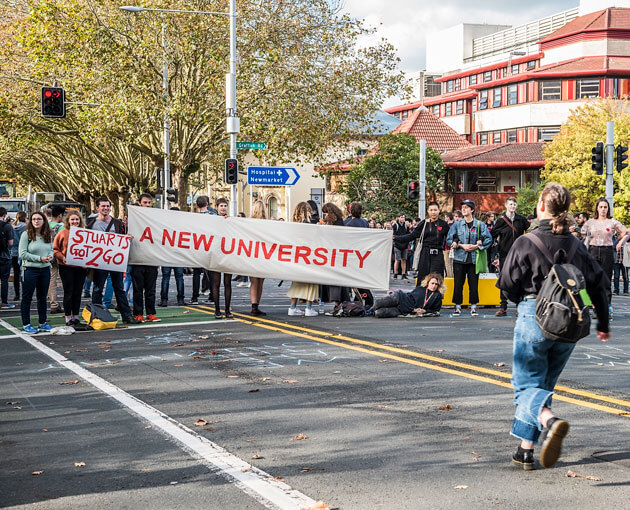
Is that, I ask, a battle cry for more public intellectualism? “Absolutely,” he says. “And I think universities have got a proud history of doing that. New Zealand universities are not immune to the fact that in recent times — and by recent times I mean the last couple of decades — there has been a more commercialised focus… Universities have to operate responsibly, they have to operate within their means. But they also have to ensure that as part of operating responsibly, they’re fulfilling all of their functions. And one of those functions is to be the intellectual powerhouses of society. And that includes putting ideas out into the public that might be new and that might be challenging, and that might stimulate heated debate.”
Right now, Hipkins is working on his own tertiary education strategy, which is likely to go out for public discussion shortly and will kick in from 2020. It’s clear that his approach is as much about righting what he perceives as the wrongs committed by the previous National-led Government as it is about planning for the nation’s future. It also promises to be one of the biggest attitudinal shifts towards tertiary education in a generation, by placing much more emphasis on higher education as a public — as well as an economic — good.
The current Government has already made three big plays in the tertiary sector. The first was signalling that the international student market needs to change, fast. “The stuff around international-student exploitation, particularly from India, damaged New Zealand’s reputation internationally,” Hipkins says. “We’re working very hard to ensure that we’re driving low-quality provision out of the market, and that New Zealand’s value proposition in international education is that we’re providing a gold standard of education, that it isn’t just seen as a moneymaking-on-the-side business.”
The second has flown relatively under the public radar. One of Steven Joyce’s most controversial moves as National’s Tertiary Education Minister was changing the makeup of university councils — the ultimate governing bodies within universities — by reducing their size and removing compulsory student and staff representation. Critics saw this as a kind of undemocratic hijacking, which moved councils closer to corporate boards of directors. Hipkins has reinstated compulsory staff and student spots.
“The legislation is pretty clear about what constitutes a university,” he says. “A university is not buildings and books; it’s people. So they should be involved in the governance of it. It’s very, very clear from the results we’ve had that removing staff and students didn’t lead to better governance of those institutions.”
The real headline-grabber, though, has been the first-year-fees-free policy, pilloried by the National opposition as a middle-class subsidy and a waste of public money. But for Labour, it’s a key ingredient in its economic plans — because it ties directly to its future-of-work strategy. Hipkins is frustrated that so much of the conversation about the policy focuses on universities, when it’s actually available right across the tertiary sector. “It’s really about saying that, in terms of a New Zealander’s education, a school qualification is no longer really enough,” he explains. “They need to be doing something over and above the school qualification in order to be able to be a fully productive, contributing member of the economy and of broader society. So we want to create as many opportunities as possible for people to take up that option.”
Which sounds, on the face of things, an awful lot like the Knowledge Wave rhetoric of two decades earlier. But there are two differences. The first is that Hipkins wants to shift public perceptions around jobs that we haven’t taken seriously enough during the knowledge-economy era, and where we have profound shortages: the trades are one example (as the Christchurch rebuild exposed), and teaching another.
The teacher shortage is a particular crisis for him, given he faces industrial action from the primary and secondary sectors, and that a big complaint from the unions is the shortage of new teachers coming through. Which is why, I suggest, it must really burn that the University of Auckland is making cuts in the education and social work faculty and moving the programme from its Epsom campus. “I’m not convinced that merging the colleges of education in with the universities was the best decision,” Hipkins says. “But that’s where we are; we can’t unscramble that egg.” One answer, he tells me, is more on-the-job training schemes, like Teach First.
McCutcheon doesn’t agree about the mergers, seeing them as a good thing for teaching. And he argues that the teacher shortage is simple to understand: the money isn’t good enough, and young people now have a far wider choice of better-paid careers — particularly in the STEM subjects, where the major crisis for the secondary sector exists.
This is the real problem for Hipkins. The government can’t — and shouldn’t — tell universities what to teach. And universities can’t tell students what to study. As a result, a strangely self-fulfilling circle has emerged, where institutions put their money into the seats student bums are most inclined to fill, which then make those areas more attractive as subjects, because students see them as better resourced. At the moment, it’s things like engineering rather than education.
Without specific legislative or financial levers, Hipkins can only really hope to change one thing: the narrative. And this is where the second difference from the original Knowledge Wave rhetoric kicks in, though you have to pay close attention to notice it. “One of the things informing our thinking in this space,” Hipkins says, “is that technological change means the idea of a qualification for life and a job for life just isn’t really applicable any more. People are going to need to be retraining right throughout their working life.”
That is the political spin, because no government is going to be honest right now about what this could really mean: the “robocalypse”. There are various theories about the impact of artificial intelligence and widespread automation on the human labour force, but there’s no question it will be big, or that it is coming. Even if we place it conservatively at the middle of the century, in 2050, the 18-year-old starting university this year will be 49 when it hits: historically in the prime earning years, potentially wiped out by a machine that is, frankly, a whole lot cleverer. This is the true crisis for tertiary education. This is the true future of work.
So retrain to do what, exactly, when the narrative is quickly switching from “how can machines improve my productivity?” to “what will I be able to do that machines can’t?”
Hipkins makes the point that a white-collar profession like accounting is already having to navigate the impact of automation. But any vocation that relies heavily on computers now will eventually succumb to AI. Lawyers who work by analysing existing case law and legislation will be replaced. Intelligent machines will do much diagnostic medical and scientific work. Architecture and engineering will be decimated.
Ironically, the very professions we’ve least valued are likely to prove the most resistant to technological usurpation, at least in the medium term: empathy-based jobs like teaching, social work, care and nursing, or jobs that involve fine motor skills that robots will be useless at for a long time yet — like, for example, the trades.
Hipkins, of course, is not going to say anything so pessimistic. But he does want to shift the conversation. “I think we as a society … have to think more about how we are encouraging young people to think about their education as an investment in themselves, rather than as preparation for a job. Because it’s actually about being a better person, and if you’re a better person, then you’re going to be a more desirable employee. So I think if people start viewing education in those terms, then we’ll be making progress.”
That is a magnificent aspiration. But it is also cold comfort to the 18-year-old who’s deciding whether to take out a big debt for a degree to then enter a melting, climate-changed world where there’s no job certainty, where they’ll eventually be competing with intelligent machines, and where they have no serious chance of owning a home unless Mum and Dad buy it for them. Because that, frankly, is a terrible deal. And we should be ashamed it’s what we’ve got to put on the table.
Universities teach us that the future is a choice, not an inevitability. For 20 years, New Zealand universities have rolled the dice on the future, trying to take control of it by harnessing the languages of free markets, globalisation, efficient management, and techno-utopianism. And that isn’t over yet. The University of Auckland’s new engineering building, only half-built, already looms over Symonds St. Promotional boards outside the Newmarket campus declare that “A new era for education begins”, while celebrating health and energy technologies, manufacturing and materials research, infrastructure and environment research. STEM, STEM, STEM, everywhere you look, venerated as though we aren’t creating the technologies that guarantee our future obsolescence.
McCutcheon’s own belief in the potential is still pure. When I ask him about any regret he may have about his 14 years at the University of Auckland, it’s that “I’ve never persuaded any government, any minister, to be genuinely interested in the future of the universities… Until we create modern, high-tech, low-weight exports, I think the country’s going to struggle. And those kinds of industries come out of universities.”
But at this point, it’s hard to see how a change of vice-chancellor at the end of 2019 will change very much, because McCutcheon ultimately isn’t the issue: the system is. It’s taken a generation of bureaucracy, of commercialisation and economic anxiety, to break down one of the most important aspects of our universities: the public performance of critical thinking — not just about how the world is, but how society, and our universities, could be. Beyond the specifics of this library closure or that arts lecturer being made redundant, this is the real loss — right at the moment we need that thinking most.
And we may not have a generation to get it back. Because despite what the universities tell us, there’s no guarantee the future will be brighter. Perhaps it’s time, then, for a reckoning: time to find out how honest we really want to be about the world we’re preparing our young people for, and how much we’re prepared to pay for it.
Photography by: Rebekah Robinson

